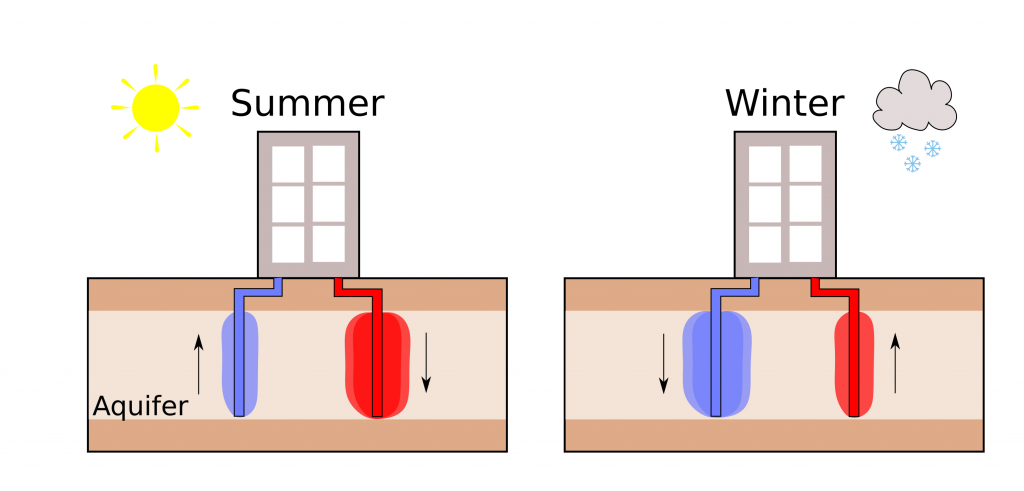By Geraldine Regnier a PhD student in the Department Earth Science and Engineering and a member of the second Transition to Zero Pollution PhD cohort and the Science and Solutions for a Changing Planet DTP
Heating and cooling of the built environment accounts for half of the world’s energy consumption. As of today, 75% of this energy is produced from fossil fuels. In order to move towards a net zero society, it is essential to look at decarbonising this sector. This challenge was also included in the UK government’s recent “Ten Point Plan for a Green Industrial Revolution”, setting out a path which moves away from gas boilers for heating of buildings towards lower carbon alternatives such as heat pumps.
A technology which could be implemented to provide large-scale low-carbon heating and cooling of buildings is Aquifer Thermal Energy Storage (ATES) where thermal energy is stored at shallow depths in the subsurface (20-200m) in layers of water-bearing rock (an aquifer). This is a technology that can be used to provide space heating and cooling to large buildings such as university campuses and hospitals as well as small-scale domestic and commercial buildings.
The operating principle of an ATES system is shown in the Figure below. Usually, an ATES system will consist of two wells: one ‘warm’ well and one ‘cold’ well. In the winter, water is pumped from the ‘warm’ well and the water temperature is raised using a heat pump to obtain a suitable temperature for heating. The water is then circulated through buildings to provide heating and, finally, reinjected at a lower temperature at the ‘cold’ well. In summer, the process is reversed. Cold water is pumped from the ‘cold’ well to directly cool buildings. The water is then re-injected at a warmer temperature at the ‘warm’ well.

The potential for ATES worldwide is widespread. The only pre-requisites for an ATES development are the presence of a seasonal climate (i.e. seasonal energy demand) and a large aquifer. The UK is therefore an ideal candidate for large-scale ATES implementation, with the presence of large aquifers such as the Chalk Aquifer or the Sherwood Sandstone Aquifer which underlie major urban and industrial centres. Currently, uptake in the UK is low with only a few projects of a total capacity of 12MW (current heating and cooling demand is of the order of 50GW for comparison). One of these ATES installations is situated just a few miles away from Imperial College in the Wandsworth Riverside Quarter with 8 wells provides heating and cooling to 500 flats.
Developing and operating sustainable ATES deployments is challenging and a number of considerations must be taken into account: where will wells be placed, how can an optimal efficiency be reached to recover a maximum of the injected thermal energy, how will local conditions such as ambient groundwater flow or geological heterogeneity affect the efficiency of such systems?

My PhD focusses on addressing some of these questions through numerical modelling of ATES systems. From homogeneous aquifers to complex heterogeneous aquifers, I look at how numerical modelling can inform us on how to develop sustainable and efficient ATES deployments. We aim to inform policy makers and industry professionals on how to best plan and operate these systems, regarding optimal well locations, operating strategies for maximum thermal recovery and avoiding groundwater pollution. This will be key for the successful deployment of ATES projects and therefore increasing the uptake in ATES in the UK and beyond.